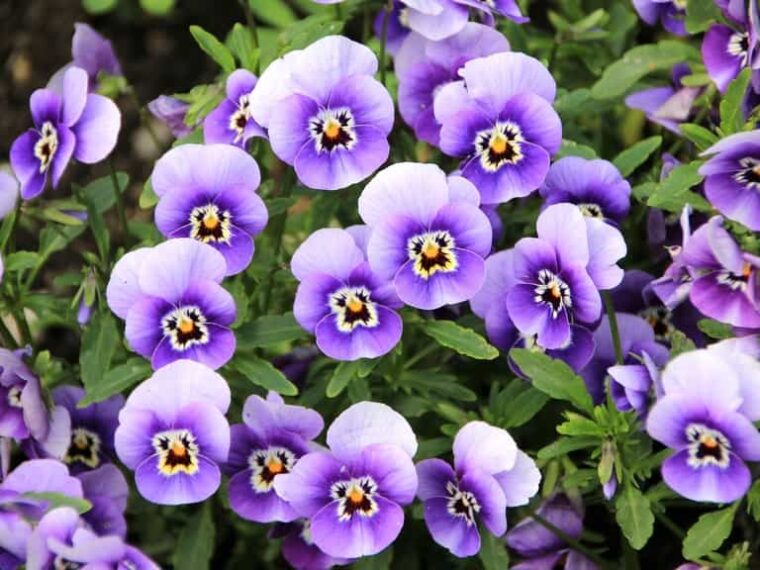Pansies are those cheerful little flowers that brighten up any space with their vibrant colors and charming patterns. If you’ve ever wanted to enjoy their beauty inside your home, you’re in the right place. Growing pansies indoors is absolutely doable — as long as you know their needs.
Let’s walk through everything you should know to keep your indoor pansies thriving, from light and water to soil and propagation.
What Are Pansies? A Quick Intro
Pansies come in an amazing variety of colors and shapes, but most of them share the same basic care requirements. These plants are naturally suited to cooler weather, so they prefer environments that don’t get too hot or stuffy.
Here’s a quick snapshot of what makes pansies special:
- Type: Biennial (they live for about two years)
- Climate: Cool, not hot
- Light: Bright but indirect
- Soil: Well-draining, moist but not soaked
- Water: Moderate — avoid overwatering
- Propagation: Easy to grow from seeds, cuttings, or divisions
Choosing the Right Container for Your Pansies
Your pansies need containers that keep their roots happy and dry enough to avoid rot. Here’s what to look for:
- Drainage holes: Essential to let excess water escape
- Material: Terracotta is ideal because it soaks up some moisture; plastic or metal containers work if they have drainage holes
- Size: Small pots work if you have a single plant, but if you’re planting several, make sure to leave about six inches between each so they have room to grow
- Style: You can get creative! Bright bowls or decorative pots make your pansy display pop indoors
Soil: The Foundation of Healthy Pansies
Pansies love soil that drains quickly but still holds nutrients well. Here’s how to choose or prepare the right mix:
- Use standard potting soil formulated for container plants
- For faster drainage, a cactus or succulent mix works but may require more frequent watering
- You can improve drainage by mixing in perlite or sand
- Avoid heavy soils that stay soggy, since wet roots can quickly harm your pansies
Lighting Your Indoor Pansies Need to Shine
Light is critical for pansies to bloom and grow strong, but the kind of light matters:
- Aim for at least 6 hours of bright, indirect light daily
- Avoid harsh, direct afternoon sun, especially in summer—it can scorch leaves and fade flowers
- The best light is usually morning or late afternoon sun
- If your window gets strong direct light, use a sheer curtain or move plants slightly away during peak hours
Watering Your Pansies: How to Get It Right
Watering is often the trickiest part of caring for pansies indoors, but with a little attention, it’s easy to master:
- During their growing season, give them about one inch of water per week
- In winter or dormancy, reduce watering
- Always check the soil before watering: stick your finger about an inch deep — if it feels moist, hold off watering
- Avoid letting water sit in the pot’s saucer to prevent root rot
- Water gently and gradually to keep soil evenly moist but never soaked
Temperature and Humidity: Creating a Comfortable Home
Since pansies love cooler air, managing temperature and humidity indoors is key:
- Keep temperatures between 55°F and 70°F (13°C–21°C)
- If your home gets warmer than 70°F, your pansies might start to wilt
- Pansies prefer moderate humidity—not too dry, not too humid
- In winter, when heating dries the air, lightly mist your plants every few days to maintain moisture without soaking them
Feeding Your Pansies: Fertilizer Tips
To help your pansies show off their best blooms, they need a little extra nutrition:
- Start feeding about four weeks after planting
- Use a diluted, balanced liquid fertilizer
- Feed them every two weeks during the active growing season
- Avoid over-fertilizing, which can damage roots and reduce flowering
Pruning and Deadheading: Keep Your Pansies Fresh and Blooming
To keep your pansies looking lively and encourage more flowers, regular trimming is important:
- Cut back any leggy or weak stems, especially those that get too much sun
- Remove dead or dried flowers immediately—this not only tidies up your plant but also promotes new buds and reduces pest risks
- Pruning encourages bushier growth and a fuller, healthier appearance
How to Multiply Your Pansies: Propagation Made Simple
Want more pansies? You can easily create new plants in a few different ways:
From Seeds
- Plant seeds in fresh, well-draining soil mixed with perlite
- Keep the soil lightly moist and maintain temperatures around 70°F to 75°F
- Seedlings typically sprout within 1–2 weeks
From Cuttings
- Take a healthy cutting about 3 inches below a node on a mature plant
- Remove the lower leaves and plant in nutrient-rich, well-draining soil
- Best done in late summer or early fall for good results
Dividing Plants
- Carefully remove the plant from its pot
- Gently separate the roots into sections, each with healthy roots attached
- Replant the divisions into fresh soil
- Note: Not all pansy varieties respond well to division, so check your plant type first
Are Pansies Safe Around People and Pets?
Here’s something interesting: Pansies are edible and add a peppery, wintergreen flavor to salads, desserts, and more. You can safely enjoy these colorful flowers in your dishes.
However, if you have pets, be cautious. Pansies are mildly toxic to cats and dogs. Eating them can cause mild stomach upset or worse in large amounts. Keep your furry friends away from these plants to avoid any issues.
Final Thoughts: Growing Your Indoor Pansy Garden
Growing pansies indoors can be a rewarding experience that fills your space with color and charm. With the right container, soil, light, water, and care, you’ll enjoy their cheerful blooms for months.
Remember to:
- Keep your pansies cool and comfortable
- Water just enough without drowning them
- Feed and prune regularly to encourage fresh growth
- Protect your pets from accidental nibbling
Ready to Bring Pansies Into Your Home?
Why not start your indoor pansy garden today? Whether you’re a seasoned plant lover or just beginning, pansies are a fantastic choice to brighten your living space.
Take the first step: Find the perfect pot, pick out your favorite pansy colors, and watch your indoor garden bloom!
If you have any questions or want to share your growing success, drop a comment below or join a plant-loving community online. Your pansies—and your home—will thank you!




